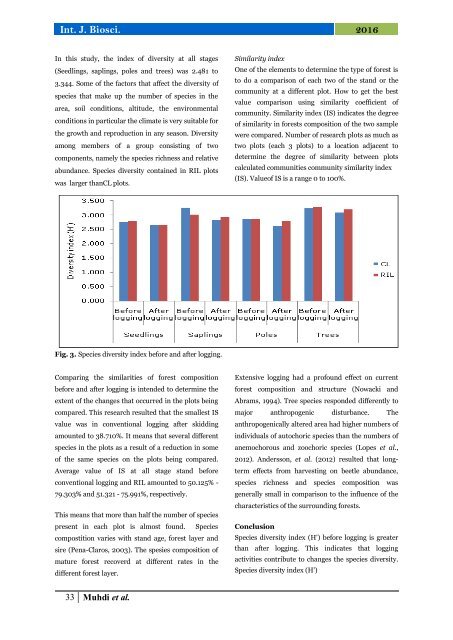Effect of reduced impact logging to species composition and forest structure in tropical rain forest, North Borneo
Forest structure and species composition is the use of sustainable forest management, such as logging methods and underplanting. Diversity of species in tropical forest is very large and complex, its existence influence each other and interact with a genetic characters and the ecosystem. Measuring the impact of logging techniques of reduced impact logging (RIL) and conventional logging (CL) performed on the logging block of the current year. Plots consisted of CL and RIL block that the size of plot 15 ha, respectivly. Before logging in the conventional logging (CL), red meranti (Shorea spp.) were the dominant species at the tree stage (IVI=15.66-32.83 %) and after logging red meranti (Shorea spp) were dominant species (IVI=19.51-38.58%). Before logging in the reduced impact logging (RIL), red meranti (Shorea spp.) were the dominant species at the tree stage (IVI=26.84-30.87 %) and after logging red meranti (Shorea spp) were dominant species (IVI=18.27-19.71%).Species diversity index (H') before logging is greater than after logging. This indicates that logging activities contribute to changes in species diversity. Species composition responded differently caused by logging technique.
Forest structure and species composition is the use of sustainable forest management, such as logging methods and underplanting. Diversity of species in tropical forest is very large and complex, its existence influence each other and interact with a genetic characters and the ecosystem. Measuring the impact of logging techniques of reduced impact logging (RIL) and conventional logging (CL) performed on the logging block of the current year. Plots consisted of CL and RIL block that the size of plot 15 ha, respectivly. Before logging in the conventional logging (CL), red meranti (Shorea spp.) were the dominant species at the tree stage (IVI=15.66-32.83 %) and after logging red meranti (Shorea spp) were dominant species (IVI=19.51-38.58%). Before logging in the reduced impact logging (RIL), red meranti (Shorea spp.) were the dominant species at the tree stage (IVI=26.84-30.87 %) and after logging red meranti (Shorea spp) were dominant species (IVI=18.27-19.71%).Species diversity index (H') before logging is greater than after logging. This indicates that logging activities contribute to changes in
species diversity. Species composition responded differently caused by logging technique.
- No tags were found...
Create successful ePaper yourself
Turn your PDF publications into a flip-book with our unique Google optimized e-Paper software.
Int. J. Biosci. 2016<br />
In this study, the <strong>in</strong>dex <strong>of</strong> diversity at all stages<br />
(Seedl<strong>in</strong>gs, sapl<strong>in</strong>gs, poles <strong>and</strong> trees) was 2.481 <strong>to</strong><br />
3.344. Some <strong>of</strong> the fac<strong>to</strong>rs that affect the diversity <strong>of</strong><br />
<strong>species</strong> that make up the number <strong>of</strong> <strong>species</strong> <strong>in</strong> the<br />
area, soil conditions, altitude, the environmental<br />
conditions <strong>in</strong> particular the climate is very suitable for<br />
the growth <strong>and</strong> reproduction <strong>in</strong> any season. Diversity<br />
among members <strong>of</strong> a group consist<strong>in</strong>g <strong>of</strong> two<br />
components, namely the <strong>species</strong> richness <strong>and</strong> relative<br />
abundance. Species diversity conta<strong>in</strong>ed <strong>in</strong> RIL plots<br />
was larger thanCL plots.<br />
Similarity <strong>in</strong>dex<br />
One <strong>of</strong> the elements <strong>to</strong> determ<strong>in</strong>e the type <strong>of</strong> <strong>forest</strong> is<br />
<strong>to</strong> do a comparison <strong>of</strong> each two <strong>of</strong> the st<strong>and</strong> or the<br />
community at a different plot. How <strong>to</strong> get the best<br />
value comparison us<strong>in</strong>g similarity coefficient <strong>of</strong><br />
community. Similarity <strong>in</strong>dex (IS) <strong>in</strong>dicates the degree<br />
<strong>of</strong> similarity <strong>in</strong> <strong>forest</strong>s <strong>composition</strong> <strong>of</strong> the two sample<br />
were compared. Number <strong>of</strong> research plots as much as<br />
two plots (each 3 plots) <strong>to</strong> a location adjacent <strong>to</strong><br />
determ<strong>in</strong>e the degree <strong>of</strong> similarity between plots<br />
calculated communities community similarity <strong>in</strong>dex<br />
(IS). Value<strong>of</strong> IS is a range 0 <strong>to</strong> 100%.<br />
Fig. 3. Species diversity <strong>in</strong>dex before <strong>and</strong> after <strong>logg<strong>in</strong>g</strong>.<br />
Compar<strong>in</strong>g the similarities <strong>of</strong> <strong>forest</strong> <strong>composition</strong><br />
before <strong>and</strong> after <strong>logg<strong>in</strong>g</strong> is <strong>in</strong>tended <strong>to</strong> determ<strong>in</strong>e the<br />
extent <strong>of</strong> the changes that occurred <strong>in</strong> the plots be<strong>in</strong>g<br />
compared. This research resulted that the smallest IS<br />
value was <strong>in</strong> conventional <strong>logg<strong>in</strong>g</strong> after skidd<strong>in</strong>g<br />
amounted <strong>to</strong> 38.710%. It means that several different<br />
<strong>species</strong> <strong>in</strong> the plots as a result <strong>of</strong> a reduction <strong>in</strong> some<br />
<strong>of</strong> the same <strong>species</strong> on the plots be<strong>in</strong>g compared.<br />
Average value <strong>of</strong> IS at all stage st<strong>and</strong> before<br />
conventional <strong>logg<strong>in</strong>g</strong> <strong>and</strong> RIL amounted <strong>to</strong> 50.125% -<br />
79.303% <strong>and</strong> 51.321 - 75.991%, respectively.<br />
This means that more than half the number <strong>of</strong> <strong>species</strong><br />
present <strong>in</strong> each plot is almost found. Species<br />
compostition varies with st<strong>and</strong> age, <strong>forest</strong> layer <strong>and</strong><br />
sire (Pena-Claros, 2003). The spesies <strong>composition</strong> <strong>of</strong><br />
mature <strong>forest</strong> recoverd at different rates <strong>in</strong> the<br />
different <strong>forest</strong> layer.<br />
Extensive <strong>logg<strong>in</strong>g</strong> had a pr<strong>of</strong>ound effect on current<br />
<strong>forest</strong> <strong>composition</strong> <strong>and</strong> <strong>structure</strong> (Nowacki <strong>and</strong><br />
Abrams, 1994). Tree <strong>species</strong> responded differently <strong>to</strong><br />
major anthropogenic disturbance. The<br />
anthropogenically altered area had higher numbers <strong>of</strong><br />
<strong>in</strong>dividuals <strong>of</strong> au<strong>to</strong>choric <strong>species</strong> than the numbers <strong>of</strong><br />
anemochorous <strong>and</strong> zoochoric <strong>species</strong> (Lopes et al.,<br />
2012). Andersson, et al. (2012) resulted that longterm<br />
effects from harvest<strong>in</strong>g on beetle abundance,<br />
<strong>species</strong> richness <strong>and</strong> <strong>species</strong> <strong>composition</strong> was<br />
generally small <strong>in</strong> comparison <strong>to</strong> the <strong>in</strong>fluence <strong>of</strong> the<br />
characteristics <strong>of</strong> the surround<strong>in</strong>g <strong>forest</strong>s.<br />
Conclusion<br />
Species diversity <strong>in</strong>dex (H') before <strong>logg<strong>in</strong>g</strong> is greater<br />
than after <strong>logg<strong>in</strong>g</strong>. This <strong>in</strong>dicates that <strong>logg<strong>in</strong>g</strong><br />
activities contribute <strong>to</strong> changes the <strong>species</strong> diversity.<br />
Species diversity <strong>in</strong>dex (H')<br />
33 Muhdi et al.

















